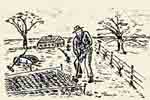|
A History of
John W. Jones
His association with area abolitionists
and his connection with the
First Baptist Church of Elmira
by
For photographs of John Jones' last house and an account of the progress
of the John W. Jones Museum in Elmira, click
here
Conclusion
Another part of John W. Jones's life for which he is very well known
both in the North and in the South is his burial of the many Confederate
prisoners that died in the Elmira Prison Camp. The prison camp was opened
on July 6, 1864, in buildings used earlier when the area was a training
ground for Union troops. Conditions in the prison camp were terrible.
There was over crowding, it was way too cold for those southern boys,
they were still living in tents in December. In the spring there was flooding,
and Foster Pond, the source of their drinking water, was contaminated.
Everything that could go wrong, did go wrong.
When the camp was closed, one year later, on July 10, 1865, almost 3,000
Confederate soldiers had died. With compassion John W. Jones supervised
their burial in an area back of his farm. He kept accurate records of
each soldier, by name, rank, company and regiment, grave number and date
of death. He placed a nicely painted wooden marker on each grave. Washington
accepted his records and he was paid $2.50 for each burial.
There is in Clay Holmes' book The Elmira Prison Camp a story
that Sexton Jones saw the name John R. Rollins on one of the coffins to
be buried and wondered if this could be the John R. Rollins he had known
as a little boy, the son of the overseer, and whose mother had always
been kind to John Jones. He contacted the family in Virginia, found that
their son had enlisted in the army and was listed as missing. He sent
word back to them that their son's body had been found. The name John
R. Rollins does not appear on the list of those buried. His remains may
be one of the three removed soon after the war.
At the time of these horrific tragedies, John Jones suffered a personal
tragedy when his three-year-old son, George Henry Jones, died on October
20, 1864.
Between 1847 and 1877, Mr. Jones was not only sexton but usher and general
helper, as the church body was small. In 1877 Dr. William T. Henry came
to First Baptist to serve his one and only pastorate. He was at the church
for 50 years. Dr. Henry's leadership caused the church membership to soar.
John Jones and his daughter, Ida, were baptized and became church members
in 1878. A larger building was needed. The New England-style building
was torn down about 1890 and a new brick building was dedicated in 1892.
The church wanted more space and bought the neighboring property of John
Jones and tore down his house. Mr. Jones then retired to his farm on College
Avenue. He gave up the job as sexton because the new church building was
larger and because he was 73 years old. He did continue as head usher
and always sat in the back pew. A seating chart of 1895 shows his pew
along with those of all the other members.
Mr. Jones also had some other jobs along with being church sexton. He
was caretaker of three different cemeteries; the Baptist Burying Ground
or Wisner Burial Grounds, which we now know as Wisner Park. The Wisner
Burial Ground opened in 1802 and closed in 1876 when all the bodies were
moved to either Second Street or Woodlawn cemeteries. Mr. Jones was also
sexton for both of those cemeteries.
My husband and I visited Leesburg, Virginia, to look up the plantation
from which 27-year-old John Jones had fled slavery. The terrain around
Leesburg is much like Chemung County. We even found an old picture of
the Ellzey plantation house "Mt. Middleton" that burned down in 1950.
At the library in Leesburg, I was given a copy of Sally Ellzey's will
and inventory, and a map by which we located the old Ellzey cemetery and
the grave of Miss Sally.
Excerpts from Miss Sally Ellzey's will dated April 28th, 1852, reveal
her attitude toward her family and servants. Her inventory indicates her
economic status:
"I expect that Alfred Lee and John Milton Lee will both wish to be sold
or hired near where their wives and children live. If they do I hope my
nephews, Burr Wm Harrison and Thomas L. Ellzey will attend to it and try
to get them comfortable and permanent homes in the county where I live."
Then comes: "I give to Thomas L. Ellzey the man that his cousin does
not chuse, Jenney and the children she has with her and her son Henry.
If payments of my debts does not require to have Jenny's eldest daughter
Martha and her child, or children, sold, I wish her to be hired out and
her wages to be devoted to the education of Frances Ellzey, daughter of
Thomas L. Ellzey and Helen E. Ellzey his wife, and in case of her death,
to her sisters, Alice and Mary B. Ellzey."
In Sally Ellzey's inventory are listed possessions such as 1 dozen cane
seat chairs, $15; 1 passage lamp, $2; preserving kettle, $2.50; cow, $20;
hay, $10; and slaves: Alfred aged 39, $750, John Milton age 37, $800;
Jenny, 41, and infant Betty, $600; Martha aged 18, $800; Dennis aged 52,
[he's old and only worth] $75. After reading this, I wondered just how
much I'd be worth if I were one of Miss Sally's servants, especially at
my advanced age and with rheumatism to boot.
For photographs of John Jones' last house and an account of the progress
of the John W. Jones Museum in Elmira, click
here
Sources
Chemung County — 1890 - 1975,
Thomas Byrne.
The will of Sarah Ellzey, made on April 28, 1852.
City Directories of Elmira, New York, for the years 1857,
1860, 1862-62 and 1863-4.
Membership records of First Baptist Church of Elmira,
1832 to present.
History of Tioga, Chemung, Tompkins and Schuyler
Counties, New York, 1879.
The Elmira Prison Camp, Clay Holmes, 1912.
The Liberator (Boston), November 15, 1850.
The Underground (Freedom's Road), Arch Merrill.
The Underground Rail Road, William Still.
A History of the Park Church, 1846 -1892, Eva
Taylor.
History of Chemung County, 1836 - 1892, Ausburn
Towner.
Paper about Simeon Benjamin by Carol L. Veldman Rudie,
on file at the Chemung County Historical Society.
Information about Francis Hall, Weekly Gazette and
Free Press, (Elmira) August, 1902.
Information about Gerrit Smith. The Encyclopedia
Americana, 1975 Edition.
|



